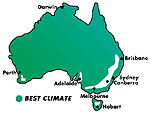This South African native was once a very popular ornamental plant, but it’s now a serious bushland weed in some areas of Australia.
Common name: Mickey Mouse bush or ochna
Botanic name: Ochna serrulata
Description: An evergreen shrub to 2m (6′) tall. Ochna has glossy green leaves with wavy, finely serrated edges and bronze new growth. In spring, bright yellow flowers appear on the plant. When the petals fall black berries form and some of the small, leaf-like structures at the base of the flower (called sepals) turn red. The red with the black berries resembles a Mickey Mouse face, hence the plant’s common name.
Problem areas: Ochna is a common garden escapee in New South Wales and Queensland. In some areas of New South Wales it has been declared a noxious weed. It will grow in all parts of Australia except the mountains.
Means of spread: Birds eat the berries, then later deposit the seeds in their droppings. Seedlings can often be found in gardens along fencelines and under trees where birds have perched. Control: Hand-weeding is not really an option. This plant has a tenacious, wiry root system and even young seedlings are hard to pull up. Unless the whole root system is removed, new plants will grow from any small pieces of root left behind. Don recommends using undiluted glyphosate, such as Zero or Roundup, to eradicate ochna. This is done by cutting the stem close to the ground and applying the herbicide to the cut surface within 30 seconds.



